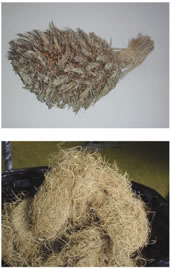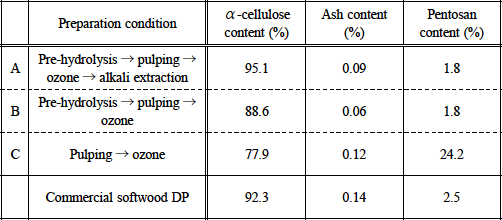Preparation of cellulose pulp from oil palm empty fruit bunches
Description
[Objectives]
As a source of palm oil, oil palm is one of the most important tree species in Southeast Asian countries such as Malaysia. However, fibrous wood-like residues that remain after oil production have not been effectively utilized so far. These are called empty fruit bunches (EFB, Photo 1) and alternative forms of utilization of EFB include the production of cellulose pulp, or dissolving pulp (DP). DP is used as a raw material of cellulose derivatives or regenerated cellulose. In this study, the preparation of DP from EFB using environment-friendly chemical technologies and methods was conducted.
[Results]
The pulping process employed in this study used soda- anthraquinone (AQ), which does not include a sulfur element that causes water pollution. EFB fibers were first hydrolyzed with dilute sulfuric acid (pre-hydrolysis), followed by the soda-AQ pulping. Ozone (O3) bleaching was then carried out on the pulp at room temperature with or without alkali extraction afterward. O3 is a powerful and less pollutant reagent in pulp bleaching, which has the potential to replace bleaching processes using chlorine-containing reagents. Chemical properties of the pulps are shown in Table 1; a pulp prepared without pre-hydrolysis (Pulp C) and a commercial softwood DP are shown for references. Contents of a-cellulose (an indicator of cellulose purity) approached 90% and above for the pre-hydrolyzed pulps (A and B), which is an acceptable level in comparison with the commercial DP. Ash and pentosan contents of the pulps, which are indicators of cellulose impurity, were also present in comparable levels. Comparing A and B, the higher α-cellulose content of A is indicative of the effectiveness of alkali extraction after O3 treatment for increasing cellulose purity. Above all, it is concluded that EFB has significant potential as a raw material to be utilized for dissolving pulp in an environment-friendly manner.
Figure, table
-
Photo 1. An empty fruit bunch (EFB, top) and its fibrous form (bottom). -
Table 1. Chemical properties of EFB pulps.
- Affiliation
-
Japan International Research Center for Agricultural Sciences Forestry Division
-
Universiti Sains Malaysia
- Classification
-
Technical A
- Term of research
-
FY2001 (FY1998-2001)
- Responsible researcher
-
TANAKA Ryohei ( Forestry Division )
WAN Rosli Wan DauD ( Universiti Sains Malaysia )
- ほか
- Publication, etc.
-
R. Tanaka, L. C. Peng and W. R. W. Daud (2002): Preparation of cellulose pulp from oil palm empty fruit bunches (EFB) by processes including pre-hydrolysis and ozone bleaching. Proceedings of the USM- JIRCAS Joint International Symposium ~ Lignocellulose - Material of the Millennium: Technology and Application, Penang, Malaysia, Universiti Sains Malaysia, 33-38.
R. Tanaka and W. R. W. Daud (2000):Preliminary studies on preparation of dissolving pulp from oil palm empty fruit bunches. Proceedings of the 5th Pacific Rim Bio-Based Composites Symposium, Australian National University, 499-502.
- Japanese PDF
-
2001_18_A3_ja.pdf952.05 KB
- English PDF
-
2001_15_A4_en.pdf63.99 KB


